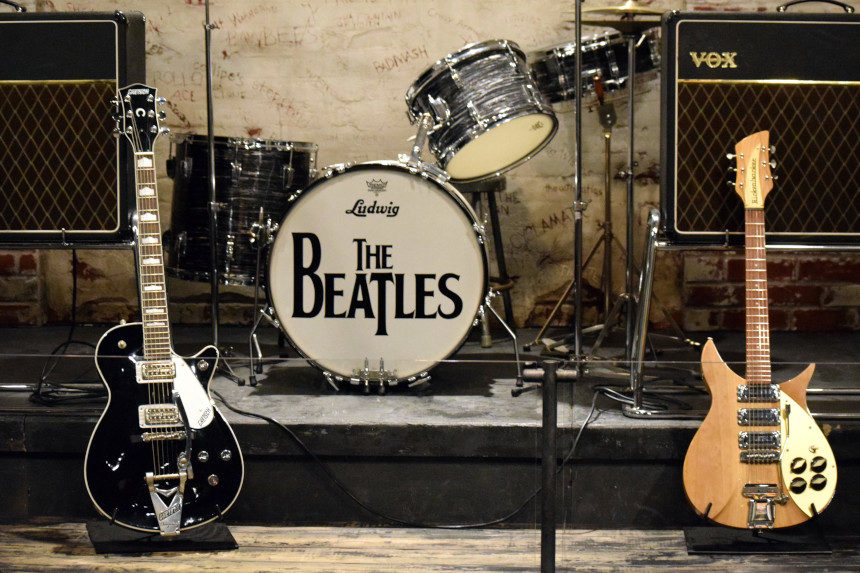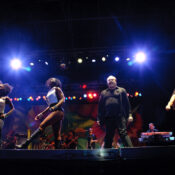One of the most frequently discussed movements in the history of modern music is The British Invasion of the 1960s. Sparked, of course, by The Beatles, the Invasion saw a wave of musical acts storm the U.S. charts from across the pond. The Rolling Stones, Dusty Springfield, The Who, The Kinks, and many more became household names and radio staples. They influenced fashion, inspired social commentary, and, some say, widened the generation gap. While it’s generally agreed that the initial movement had died off by 1967, you can actually narrow the beginning of the end down to around the last week of April, 1966. Here’s how the British Invasion started, ended, and returned.
The Beatles play “I Want To Hold Your Hand” on The Ed Sullivan Show. (Uploaded to YouTube by The Beatles)
This much is certain. The first inkling that the U.S. had that something of musical portent was happening in England came from newspaper articles in the fall of 1963. Various outlets started talking about “Beatlemania.” Walter Cronkite re-ran a story on The Beatles in December of that year that had previously fallen off the radar due to originally running on the same day as the Kennedy assassination. After teenager Marsha Albert wrote a letter about the group to a DJ at WWDC, the station played “I Want to Hold Your Hand.” Boom. By February 1, the song sat atop the Hot 100. On February 9, The Beatles played The Ed Sullivan Show. The Invasion was on.
Dusty Springfield, “I Only Want to Be with You” (Uploaded to YouTube by Classic Hits (Stereo))
Dusty Springfield’s “I Only Want to Be with You” was next, hitting the Billboard charts just after the lads from Liverpool. If you solely look at #1 songs, British Invasion artists accounted for 9 of them in 1964, occupying the spot for a combined 23 weeks (and, to be honest, six of those songs were by The Beatles; the other three were Peter and Gordon’s “A World without Love,” “The House of the Rising Sun” by the Animals, and Manfred Mann’s “Do Wah Diddy Diddy”). 1965’s Invasion #1s were spread around a bit more; 12 chart-toppers came from seven artists (The Beatles, Petula Clark, Freddy and the Dreamers, Wayne Fontana and the Mindbenders, Herman’s Hermits, The Rolling Stones, and The Dave Clark Five) across 26 weeks.
The Temptations and The Supremes on The Ed Sullivan Show in 1967 (Uploaded to YouTube by The Ed Sullivan Show)
It’s important to note that while the British acts were taking up essentially half of the room at the top of the charts, American acts were also furiously active. Motown was a significant force, with 110 Top Ten hits between 1961 and 1971. In 1965 alone, The Supremes alone had four #1s, along with top spots claimed by The Temptations and The Four Tops. Acts like The Beach Boys, The Byrds, Sonny & Cher, and The McCoys also took turns on top. Some critics have claimed that the British acts pushed U.S. acts out of the charts, but the reality is that the British acts pushed the American acts to be more productive and competitive. A sort of four-way push-and-pull developed between The Beatles, The Rolling Stones, The Who, and The Beach Boys throughout the 1960s, with each band inspiring one another and pushing the others to do more; The Beach Boys’ Pet Sounds helped drive The Beatles’ Revolver and Sgt. Pepper’s Lonely Hearts Club Band, and so on.
“The Sounds of Silence” by Simon & Garfunkel (Uploaded to YouTube by Simon & Garfunkel)
By April 23, 1966, there was an obvious shift on the charts. For the first time in 27 months (since January of 1964), there wasn’t a single British artist in the Top Ten. A string of 117 straight weeks had been broken. That didn’t mean that the U.K. acts were done, far from it; The Beatles, The Stones, and The Troggs would all post #1s before the year was out. However, the entire rock scene in the States had broken open in such a way that a landslide of homegrown acts like the Young Rascals, The Mamas and the Papas, The Association, Simon & Garfunkel, and more were making chart inroads. The Beach Boys and Frank Sinatra returned to #1, and The Beatles-inspired “Pre-Fab Four,” The Monkees, hit #1 twice. It’s not that the British acts were no longer popular; it’s that there was an increasing amount of material for young listeners to choose from in record stores. The Beatles had put down a new prototype for a rock band, and a number of musicians had directly or indirectly answered the call.
By 1967, the top of the charts had settled into a mix of new and established acts pulling from rock, R&B, and soul. It was an environment where you could have The Supremes replace The Stones at number one, only to be displaced by The Beatles, who would surrender their spot to The Turtles, and then Frank & Nancy Sinatra. Aretha Franklin and The Doors both went to the top. Meanwhile, the Summer of Love was positioning another new wave of American artists for stardom. The British artists had upended the charts, but they were now firmly integrated into a thriving and vital music mosaic.
“I Ran (So Far Away)” by A Flock of Seagulls (Uploaded to YouTube by A Flock of Seagulls)
But as all things run in cycles, the British Invasion did have a sequel of sorts. As bands like The Beatles began to eschew touring and live shows, they would make short films of performances that could be run at any time on the various British music shows. These shorts evolved into what we know as the music video, and they became a regular thing for English acts. When the cable network MTV launched in the U.S. in 1981, American acts were way behind on the medium, but the U.K. acts were video-ready. Consequently, bands like Duran Duran, A Flock of Seagulls, Human League, and Soft Cell began to break out. Groups from the New Wave of British Heavy Metal (like Judas Priest and Iron Maiden) planted flags in America due to MTV exposure. It took a couple of years for American artists like Michael Jackson, Prince, Madonna, and Bruce Springsteen to catch up on the video front, but they did, leading to mega-selling albums by the mid-80s.
At its heart, the story of the British Invasion begins with one simple premise: people like something new. And when something new comes along, variations of that new thing will also be popular. Over time, it either gets absorbed into the culture or discarded. While some British Invasion bands aren’t remembered as well as others, they did sink into the broader fabric of popular music. Bands with their own songwriters as part of the unit became the norm rather than the exception. That blues-influenced guitar-driven sound that Ike Turner and Chuck Berry put on wax was deified by The Beatles and The Stones; that all melded with the DNA of band-based music to become the foundation for the metal and punk and alternative rock that would follow. It’s fair to say that the British Invasion ended, but the British influence never went away.
Featured image: Jayssan / Shutterstock
Become a Saturday Evening Post member and enjoy unlimited access. Subscribe now




Comments
The question this topic poses is one I’ve never asked myself before. You did a lot of good research here and pretty well answered the question throughout these paragraphs. It’s deceiving in that appears simpler than it really is. Most things are.
By the time the Beatles broke up there was SO much great music out there by SO many singers and groups that it didn’t really matter at that point. They’d compacted so much great music into such a relatively short period of time no wonder they were tired of it, each other, having to compromise, and wanted to their own solo work—or nothing at all if they wanted to.
Personally, I’ve always felt ELO was the successor to the Beatles and Jeff Lynne has paced himself out that his voice and song writing skills are as sharp today as they were in the ’70s, now spanning 6 decades. I’d bought tickets to see them again in June ’20 months in advance, but had to get a refund. 2 of their best albums are from 2015 and ’19. Will that 8th concert come to my area? I certainly hope so!
The Smithereens in the late ’80s were one of the best American groups ever, and were influenced by the Beatles. There were plenty of singers and groups that may have been influenced too, and those seemingly with no ties to anyone. Many you mention above and others including Elton John, Cat Stevens, The Sweet, Peter Gabriel, Sheena Easton, Human League, Animotion, Alphaville, Falco (of course) the Pet Shop Boys, Information Society and more.
Sometimes the influence is none other than the era from which they came. The Rubettes (mid-70s) were heavily influenced by ’50s Doo Wop and fused it with the modern sound of 1974. So did Ringo around that time, going back to his teen American musical influences that were again very timely in the running-away-from-the-60’s years.
Your musical links here are delightful. The Dusty Springfield video was the best one of her hit you could have chosen. What a great song, including the bridge at :50 an instrumental and another bridge at 1:50. I love vintage Motown, and this Supremes/Temptations doing each others hits was incredible!! ‘The Sounds of Silence’ wonderful. Flock of Seagulls, fantastic. The closest we ever got to “the future” future. The real future is a complete disaster, so holding on to the distant past visions of happier versions will always bring a smile.
I mean really, which would you rather think of? Ugly Elon Musk with his crashing cars and burning spacecrafts to Mars, or beautiful Sheena Easton’s ‘Strut’ with that sexy futuristic dress and tantalizing geometric earrings?
Chuck Berry once said that he was influenced more by singers like Frank Sinatra than the Blues.